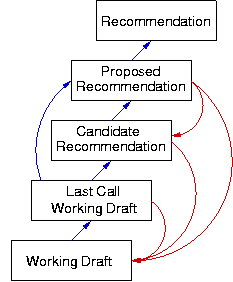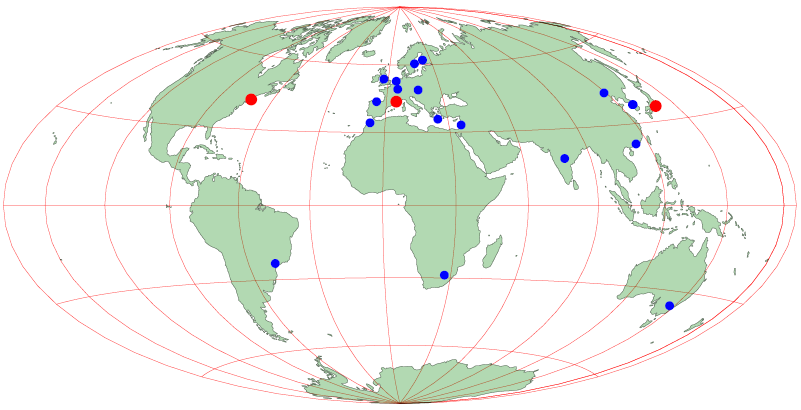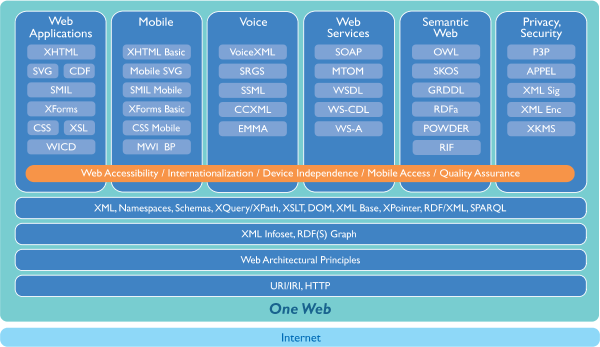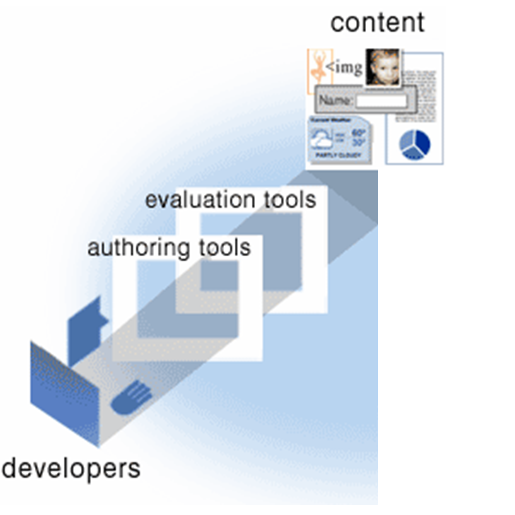About the World Wide Web
The social value of the Web is that it enables human communication, commerce, and opportunities to share knowledge. One of W3C's primary goals is to make these benefits available to all people, whatever their hardware, software, network infrastructure, native language, culture, geographical location, or physical or mental ability.
"Web for Everyone", vision of the World Wide Web Consortium (W3C)
World Wide Web Consortium (W3C)
"Att se till att webben når sin fulla potential"
(Leading the Web to its full potential)
- International, vendor-neutral consortium
- Multi-stakeholder, consensus process
- Open and royalty-free Web standards:
- HTML, CSS, XML, SVG, SMIL, ...
W3C Members
Currently more than 400 W3C Members:
- Web Industry
- Technologists
- Research & Development
- User Organizations
List of current W3C Members
W3C Process
Governs W3C work and processes:
- Consensus-based process
- Single vote per Member
- Roles and responsibilities
- Transparancy and openess
- Public accountability
W3C Process is publicy available
Standards Development
| Working Group development |
 |
| Public Working Draft |
 |
| Public review and comment |
|
 |
Document Maturity
 Working Draft
Working Draft Last Call Working Draft
Last Call Working Draft Candidate Recommendation
Candidate Recommendation Proposed Recommendation
Proposed Recommendation W3C Recommendation (Web Standard)
W3C Recommendation (Web Standard)
Development Process

W3C Hosts & Offices

W3C Sweden Office
http://www.w3c.se/
Office Manager: Olle Olsson
Tel: +46 8 633 15 19
Email: w3c-sweden@w3.org
Swedish Institute of Computer Science (SICS)
Electrum Building, Isafjordsgatan 26
P.O. Box 1263, Kista
SE-164 29, Sweden
W3C Translations
W3C welcomes translations in all languages:
- Unoffical translations
Not reviewed and not endorsed by W3C
- Authorized translations
Community review and W3C endorsement
W3C Work Areas

Web Accessibility
The power of the Web is in its universality. Access by everyone regardless of disability is an essential aspect. WAI will ensure the Web can be accessed through different combinations of senses and physical capabilities just as other W3C activities ensure its operation across different hardware and software platforms, media, cultures and countries. - Tim Berners-Lee, February 1997
Web Accessibility Initiative (WAI)
Making the Web accessible for people with disabilities:
- Operates fully under the W3C Process
- Additional funding from public grants
- Mostly publicly open Working Groups
- Makes use of Invited Expert modality
- Push-review to target user groups
- Aim is to balance multi-stakeholders
WAI Work Areas
WAI develops strategies, guidelines, resources to make the Web accessible:
- Accessibility support in W3C technologies
- Guidelines for implementing accessibility
- Methods for evaluating accessibility
- Conducting education and outreach
- Coordinating with Research and Development
Scope of Web Accessibility
Equal access for people with disabilities:
- Vision impairment - blind, partial sight, color blind, ...
- Hearing impaired - deaf, hard of hearing, ...
- Physical disability - loss of limbs, paralysis, ...
- Cognitive disability - dyslexia, intellectual, ...
- Neurological impaired - seizures, sclerosis, ...
- ...and people with multiple disabilities
- ...and people with ageing-related limitations
Web Accessibility Barriers
Examples of barriers on the Web include:
- Images, videos, audio with no alternative text
- Layout and font do not expand and shrink well
- Forms and controls can not be used by keyboard
- Inconsistent and/or overly complex navigation
- Script events are device and browser dependent
- User control, natural language, ...
Components of Web Accessibility

Web Content Accessibility

Web content is:
- natural information such as text, images, and sounds
- code or markup that defines structure, presentation, etc.
- scripts, applications and events that control interaction
Authoring Tool Accessibility

User Agent Accessibility

Simple Example

When Components Are Weak...

Summary and Conclusion
- W3C develops royalty-free Web standards
- Transparent and consensus-based process
- Work of Team, Members, and the Public
- Accessibility is a fundamental aspect
- Several opportunities for contribution
Get involved and take leadership...

 Working Draft
Working Draft Last Call Working Draft
Last Call Working Draft Candidate Recommendation
Candidate Recommendation Proposed Recommendation
Proposed Recommendation W3C Recommendation (Web Standard)
W3C Recommendation (Web Standard)






